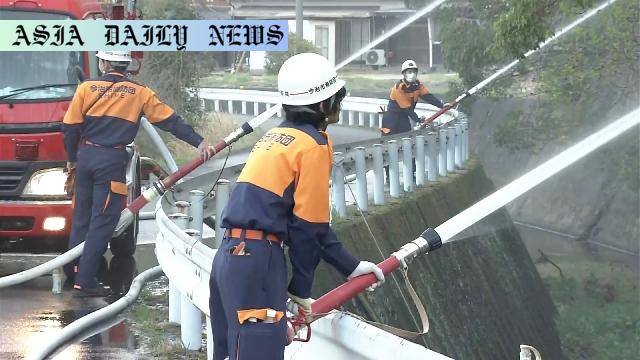Wildfires continue to spread in western Japan, with blazes expanding in Ehime, Okayama, and Miyazaki prefectures.
Wildfires continue to devastate Ehime, Okayama, and Miyazaki prefectures in western Japan.
Evacuation orders affect thousands as helicopters and firefighting crews work relentlessly.
Strong winds and dry weather further complicate the firefighting efforts.

Wildfires Ravaging Western Japan
Wildfires in western Japan are wreaking havoc across three prefectures—Ehime, Okayama, and Miyazaki. These fires have escalated into major emergencies, prompting massive evacuations and relentless firefighting operations involving the Self-Defense Forces. Residents across the regions are grappling with fear and uncertainty as flames engulf homes, forests, and public areas, causing substantial damage to properties and threatening lives.
Ehime Prefecture Faces a Deepening Crisis
In Imabari City, Ehime Prefecture, fires that originated in the Nagasawa area continue to expand. By Wednesday morning, more than 306 hectares had already been consumed by the flames, with several houses directly impacted by embers that leapt across residential areas. Despite the deployment of helicopters by the Japan Self-Defense Forces and extensive firefighting efforts from the ground, containment of the fire has proven challenging due to prolonged dry conditions. Over 6,000 people have been ordered to evacuate, seeking temporary refuge at one of seven evacuation shelters established. Despite early weather forecasts of promising rainfall, the reality of drier conditions on Wednesday has heightened fear of a worsening crisis.
Okayama Prefecture’s Dual City Battle
In Okayama, fires have blazed through vast expanses in Minami Ward and Tamano City. More than 311 hectares have burned, six structures have sustained damage, and evacuation orders remain in effect for several communities. The Kojima bay bridge has also been shut down to ensure safety, limiting transit and severing access to critical routes. Firefighting crews battled flames through the night, demonstrating unparalleled resilience. However, flames continue to encroach on homes, pushing the limits of existing resources. Helicopter operations to contain the fire began again as early as 6:30 a.m. the following day, signaling the breadth and urgency of the crisis.
Miyazaki Prefecture: A New Battle Emerges
In Miyazaki City, a new wildfire erupted in the Kagamizu area on Tuesday. Despite the swift action of four helicopters and ground crews, flames have not been subdued. As night fell, operations shifted to monitoring, with fire engines stationed nearby to tackle any sudden escalations. Authorities have issued evacuation orders for around 70 households in the vicinity of the fire. Reports indicate that while no injuries or structural damages have occurred so far, the sheer scale of this newly erupted fire remains daunting. Authorities are closely monitoring the prevailing dry weather to determine the fire’s trajectory and potential measures for containment.
Challenges Posed by Weather and Terrain
The prevailing weather conditions in all three regions are complicating firefighting measures. Strong winds and low humidity continue to fuel the wildfires, creating additional challenges for the deployed teams. Although helicopters and extensive resources are being utilized, the less predictable conditions prevent consistent progress. For communities already grappling with evacuation and home loss, these fires highlight the vulnerabilities faced during extreme weather episodes. The geographic terrain—comprising a mix of forests and urban areas—has also proven difficult as it enables the rapid spread of embers.
Current Evacuations and Long-Term Concerns
Emergency shelters across the affected areas are providing temporary relief to evacuees, but rebuilding efforts post-disaster are likely to be profound. The lack of injuries reported thus far provides a silver lining, but officials acknowledge the long-term ramifications go beyond tangible losses. With the fires still raging, investigations are underway to uncover the root cause behind the multiple blazes erupting across western Japan. This surge of wildfires is a reminder of the pressing need for disaster preparedness in the face of unpredictable natural events.
Commentary
The Devastation of Natural Disasters
Natural disasters have a unique way of upending the lives of thousands in an instant, as the ongoing wildfires in western Japan demonstrate. Witnessing the rapid spread of flames that devour homes, forests, and essential infrastructure is a powerful reminder of how small human efforts can feel in the face of nature’s fury. The individuals affected—whether those evacuated, displaced, or physically fighting the blaze—are all resilient in the shared struggle to overcome tragedy. This disaster underscores the importance of disaster preparedness, appropriate response resources, and the need for constant vigilance in mitigating such crises.
The Human Cost of Widespread Fires
In times of devastating wildfires like this, the human element of the crisis becomes profoundly evident. Behind the large-scale statistics of hectares lost and evacuation numbers are individual families who have been forced to abandon their homes and lives. Evacuation shelters, although a beacon of safety, barely comfort those who are unsure about the fate of their belongings or whether they will return to normalcy. The addition of school closures within fire-prone areas emphasizes how multifaceted such incidents can be.
Opportunities for Reflection and Change
Ultimately, this crisis—as with every natural disaster—provides moments of reflection. How prepared is Japan for recurring episodes of extreme weather? Are local governments and national authorities investing adequately in early fire detection and control measures? These are questions that will need to be answered thoroughly. Beyond immediate firefighting operations, Japan may need to evaluate its long-term strategies for weather-induced disasters, especially as climate change accelerates the frequency and intensity of such incidents. These conversations, on both a policy and societal level, are crucial in moving forward.


